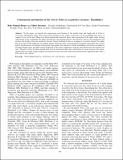Mostrar el registro sencillo del ítem
Construction and function of the web of Tidarren sisyphoides (Araneae: Theridiidae)
| dc.creator | Madrigal Brenes, Ruth | |
| dc.creator | Barrantes Montero, Gilbert | |
| dc.date.accessioned | 2019-09-10T21:54:41Z | |
| dc.date.available | 2019-09-10T21:54:41Z | |
| dc.date.issued | 2009 | |
| dc.identifier.issn | 0160-8202 | |
| dc.identifier.uri | https://hdl.handle.net/10669/79073 | |
| dc.description.abstract | In this paper, we describe the construction and function of the double sheet and tangle web of Tidarren sisyphoides (Walckenaer 1842). Web construction includes several stages: construction of the scaffolding that serves to support the rest of the web; filling in the dome-shaped and horizontal sheets; and construction of the upper tangle. During construction of the scaffolding, the spider descends by a pre-existing thread to the substrate, moves a few centimeters and attaches the dragline, then she ascends by the new thread, doubling the line or attaching it to another thread. The spider fills in the sheet while walking in an irregular pattern under the sheet, and attaching her dragline using either one or both legs IV simultaneously to hold pre-existing sheet lines against her spinnerets. During scaffolding construction and filling in the dome-shaped sheet, the spider returns frequently to the retreat, apparently using the same threads near the retreat each time. Threads of both the dome-shaped sheet and the horizontal sheet have small drops of viscid material. The dome-shaped sheet and upper tangle comprise the functional trap of the web, while the horizontal sheet apparently plays only a little role in prey capture. | en |
| dc.language.iso | en | |
| dc.source | Journal of Arachnology 37:306-311 | |
| dc.subject | Web-building behavior | en |
| dc.subject | aerial sheet web | en |
| dc.subject | web function | en |
| dc.subject | viscid threads | en |
| dc.title | Construction and function of the web of Tidarren sisyphoides (Araneae: Theridiidae) | en |
| dc.type | artículo original | |
| dc.identifier.doi | 10.1636/Sh09-16.1 | |
| dc.description.procedence | UCR::Vicerrectoría de Docencia::Ciencias Básicas::Facultad de Ciencias::Escuela de Biología |
Ficheros en el ítem
Este ítem aparece en la(s) siguiente(s) colección(ones)
-
Biología [1636]


